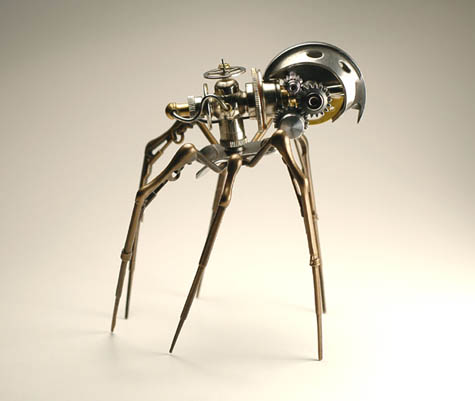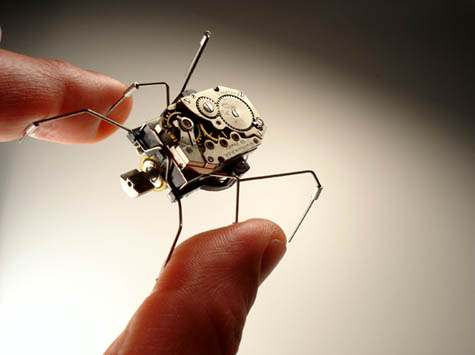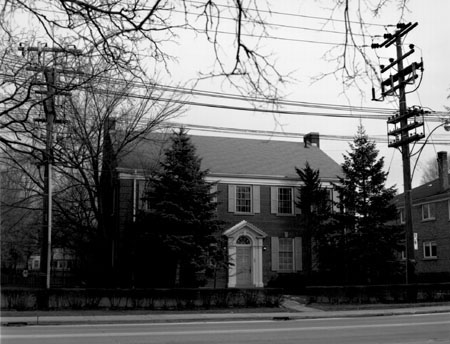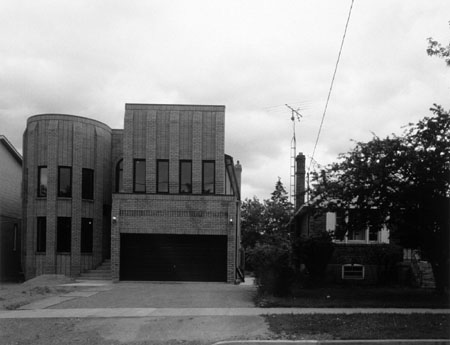It's been a while since we've visited this site, here's what he was thinking about way ahead of the stuff going mainstream.
From BLDGBLOG, March 7, 2008:
“The next time a moth alights on your window sill,” New Scientist warns, “watch what you say. Sure, it may look like an innocent visitor, irresistibly drawn to the light in your room, but it could actually be a spy – one of a new generation of cyborg insects with implants wired into their nerves to allow remote control of their movement.”
 [Image: A Steam Insect by sculptor Christopher Conte; photo by Amanda Dutton/Synesthesia Photo].
[Image: A Steam Insect by sculptor Christopher Conte; photo by Amanda Dutton/Synesthesia Photo].
What fascinates me about that statement, much more than simply pointing out how advanced surveillance technology has become, is the fact that such thoughts would have been dismissed as absolute schizophrenia as little as two decades ago.
Pointing out the window at insects as you whisper: They’re listening…
 [Image: A Battery Powered Microbotic Insect by sculptor Christopher Conte].
[Image: A Battery Powered Microbotic Insect by sculptor Christopher Conte].
Which leads me to wonder if, all along, “human history” has really just been the production, in physical form, of someone else’s mental state – our world is their dream, then, and it is their ideas within which we live. Inventors, industrialists, entrepreneurs, emperors, kings, architects, artists.
In any case, I’m also curious if these sorts of paranoias are ever directed at landscapes and the built environment. In Stasi-era East Germany, for instance, was there ever a kind of architectural paranoia, when you realized that your neighbor’s house was not, in fact, a house… but a listening post for the government.
In fact, I’m reminded of an old post on BLDGBLOG in which we saw photographs by Robin Collyer documenting houses that aren’t houses at all: they’re disguised electrical substations built to look like detached single-family bungalows.
 [Image: 555 Spadina by Robin Collyer; this is not a house but an electrical substation].
[Image: 555 Spadina by Robin Collyer; this is not a house but an electrical substation].
Will there ever be articles in New Scientist saying: “The next time you use a doorknob, it may not be a doorknob at all…”
Or: “The next time you stay in a hotel room, it may not be a hotel room at all, but a top secret government research lab…”
Is there an architectural paranoia? And, if so, what would the treatment be – walking tours of all the unmarked buildings downtown? Nights spent alone with your psychoanalyst in empty suburban houses?
How does one treat an architectural affliction?
 [Image: 96-98 Olive Ave., North York by Robin Collyer – another disguised electrical substations].
[Image: 96-98 Olive Ave., North York by Robin Collyer – another disguised electrical substations].
And what about landscape? You drive past a “cornfield” – but you know it’s not a cornfield. “This is not a cornfield,” you whisper. “I think it’s listening to us.” The stalks look funny, and they don’t sway with the wind. You and your friends go camping in the forests of northern California, but you sit there outside your tent all night, eyeing the redwoods. “These aren’t trees,” you insist every few minutes. “I don’t think these are trees.”
So can landscapes and the built environment sustain paranoid projections? If we can imagine, as per the New Scientist article cited above, that a moth at the window is really a government surveillance device, then surely we can imagine that whole buildings and fields not be what they seem?....
....MUCH MORE
Some previous visits:
Phytomining: Using Plants to Concentrate Valuable Metals as They Grow
'Shrooms: "Fungal Lightning"
"Two Water Tables"
Trees Can Kill You
Kristian Birkeland’s magnetic museum: or, ‘sunspots like no one else can do better’
He also wrote the book on the thieving mindset:
A Burgler's Guide To The City--How a Criminal Sees the World